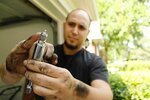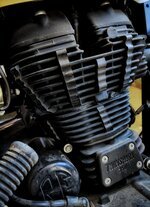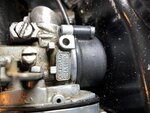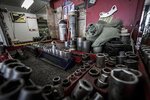How to fix motorcycle running lean? It’s quite hard to diagnose, especially considering how many components can cause the problem.
But first, what is a lean engine? When fuel is being injected into the engine, it is mixed with a certain amount of air to help combust it. When there’s more air in the mixture, your engine is said to be running lean.
So, how do you fix it? First, you need to diagnose the problem. Usually, it’s just because of some leaks or clogs. However, you could also be looking at hundreds of dollars for repairs.
Each problem requires its solution. To clean up clogged filters, wash the carburetor with a carb cleaner. For leaks, try sealing them or replacing the component.
But there’s a lot more to it. Read on to find out how to fix a motorcycle that’s running lean.
Lean Symptoms in Motorcycle Carburetors
How do you know that your bike is running lean? Here are some common symptoms:
1. Reduced Engine Power:
One of the first significant signs is that the engine power will be greatly reduced. If you notice your engine running sluggishly, it may be lean.
2. Clean Spark Plugs:

Unlike when your engine is running rich, the spark plugs will be clean with little to no residue. But check the insulator; it may appear white.
3. Constant Backfiring:
If you notice a “popping” sound, it could be backfiring. Backfiring is when combustion takes place outside the engine’s combustion chambers, typically in the exhaust.
4. Only Runs on Choke:
If your engine only runs on choke and keeps stalling when taken off the choke circuit, you have a lean engine.
5. Poor Idling:
When your engine is idle, it may rattle about or vibrate aggressively. This indicates a lean running engine.
6. Very Distinct Smell:
Take note of the exhaust smell. If it has a distinct odor that wasn’t there before, your engine could be running lean. This is due to the higher temperatures inside the engine, which generates more Nitrogen Oxide.
7. Engine Overheating:

Since the engine has too much oxygen, the temperature will be much higher when combustions occur. This will result in engine overheating, which a thermometer can gauge.
8. Better Performance at Higher Altitudes:
At higher altitudes, the atmospheric pressure is a lot lower, making it easier for the fuel to enter the venturi. This, in turn, negates the lean effect, making the engine run better at higher altitudes.
Common Lean Condition Causes
Before you learn how to fix motorcycle running lean, here’s what causes it:
1. Fuel System:
A complex fuel system is the number one cause of a lean-running engine. The most likely scenario is that your fuel filter is clogged. This reduces the fuel pressure as well as the delivery.
2. Oxygen Sensor:
There’s usually an oxygen sensor in newer bikes informing the computer about the oxygen level inside the exhaust chamber. A faulty sensor will prevent that from happening.
3. Computer Malfunction:
Just like a faulty oxygen sensor, a defective computer also affects the AFR. The computer might be sending the wrong information to the fuel injectors. But it’s not sending any signal.
4. Air Leaks:
Finally, consider that all of your sensors are working, but the engine receives more air due to leaks. The leaks are most likely in the hoses, especially near where they connect to the engine.
5 Ways How to Fix Motorcycle Running Lean
Here’s how to fix motorcycle running lean:
1. Clean the Carburetor:

The first thing you must do is clean the carburetor. More often than not, your fuel jets may be clogged.
Firstly, you’ll need to disconnect the air intake filters and remove the butterfly valves behind them. Now, unscrew the bolts around the sides of the bowl to remove them from the carburetor. Remember to turn your petcock off to avoid gas leakage.
Next, spray some carburetor cleaners inside the bowl. Do this a few times. Then, remove the floats by pushing down on the wrist pin.
Unscrew the jets and try to look through them. If it’s clogged, clean out as much as you can and then spray carb cleaner several times.
2. Fix the Float Level:
The floats on your carburetor work much like the float in your toilet tank. They indicate how high or low the fuel level is.
First, remove the floats from the carburetor by pressing the wrist pin. There will be a small rocket-like plug that will come off with them. Submerge them in a tray/bowl of water and see if they float. If they don’t, then you know they’re too heavy and not suitable. Replace the floats.
You can find some aftermarket floats. But as you’ll see later on, aftermarket parts aren’t the best deal. Instead, it’s recommended to stick to OEM parts purchased from the manufacturer’s site.
3. Get Your Fuel Injector Checked:

The fuel injector is another cause for concern. If your bike uses a fuel injector (note that not all do), it could also be a problem. It’s best first to check everything we have mentioned above and then move on to this step.
The fuel injector is what injects the fuel into the engine. Under regular operation, it will inject just the right amount of fuel. But if your fuel injector is faulty, it will not allow the correct amount of fuel to enter the engine.
Unfortunately, you cannot repair fuel injectors at home. It’s best to call a professional and let them have a look. They’ll first run a few tests to check if the fuel injector is the problem. Then they’ll propose solutions and give you the final cost.
4. Fix Any Air Leaks:
Another common cause of your motorcycle running lean is a bunch of air leaks. Air leaks not only allow air to escape but also to enter. And this can cause your motorcycle to run lean.
In most cases, the air leak is caused by faulty or old valves, hoses, and manifolds. Take a look at the inlet manifold, exhaust, the hoses that connect to and from your carburetor, and the butterfly valves.
If you find a leakage, you can either seal it up using any appropriate sealant or replace the broken component.
Another cause of air leak is the use of aftermarket parts, most notably an aftermarket air filter. The cause is typically incorrect mounting of the filter or the aftermarket component. Follow the instructions very carefully and make sure you have appropriately sealed.
If all your aftermarket parts are perfectly sealed, then you might have a vacuum leak. Vacuum leaks occur when the air enters the intake manifold directly without entering the throttle body.
Vacuum leaks may be caused by actual leaks in the system, faulty sensors, and even a faulty computer. You’ll need to have all of those checked out if you fear a vacuum leak. Unfortunately, they’re the hardest leaks to repair.
Finally, the housing of the carburetor can be cracked or leaked. This should be the first thing you’ll notice. Again, you can try sealing it up. But sealants will eventually wear out too. Consider buying a new carburetor if the situation gets out of hand.
5. Refasten the Screws:

Your carburetor most probably has a screw at the side used to control the AFR (Air-to-Fuel Ratio). If the screw has been fiddled with recently, it can cause your engine to run lean or rich.
Find the screw first. Then get on to fastening it. For this, you’ll need to consult the manual. You want to make sure that the screw is only screwed in so much so that it allows for the perfect AFR. Again, you need to look at the manual or a tutorial online on this.
If, after tightening the screw, it seems to be a bit lose, you should check out replacement screws. A loose screw will only come undone later on. So, there’s no point in working with that.
FAQ
Is backfiring lean or rich?
It’s quite hard to say. A rich running engine can cause a backfire. In a lean-running engine, the mixture splashes against the hot exhaust, it burns up, causing a backfire. Similarly, when your engine is running rich, the excess fuel gets burnt up in the exhaust.
What causes lean pops?
If you’ve noticed a popping sound from your exhaust, it’s because your engine is running lean. The air/fuel is too unreliable to burn up in the combustion chamber. Hence, it gets sent raw to the exhaust. The exhaust, being quite hot, burns the mixture up, resulting in small combustion, hence the “popping.”
Conclusion
A lean-running engine may not seem as destructive as a rich engine. Despite the symptoms being more unnoticeable, a lean-running engine is far worse than a rich one.
So, how to fix motorcycle running lean? The first step is to identify the cause. If you’re lucky, it’ll just be a leak. If not, you may need to make some expensive replacements.
Once you’ve identified the cause, proceed to fix the problem as described above. If the situation seems too bad, you’ll need to consult a professional. And remember to keep a regular check on your carburetor.


